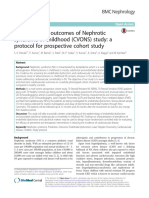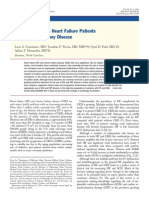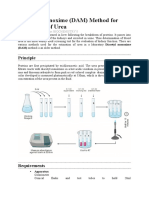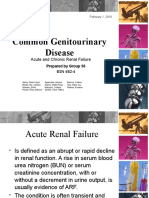Stroke in Patients With Chronic Kidney Disease : How Do We Approach and Manage It? - PMC
Stroke in Patients With Chronic Kidney Disease : How Do We Approach and Manage It? - PMC
Uploaded by
Jeffry HaryantoCopyright:
Available Formats
Stroke in Patients With Chronic Kidney Disease : How Do We Approach and Manage It? - PMC
Stroke in Patients With Chronic Kidney Disease : How Do We Approach and Manage It? - PMC
Uploaded by
Jeffry HaryantoOriginal Title
Copyright
Available Formats
Share this document
Did you find this document useful?
Is this content inappropriate?
Copyright:
Available Formats
Stroke in Patients With Chronic Kidney Disease : How Do We Approach and Manage It? - PMC
Stroke in Patients With Chronic Kidney Disease : How Do We Approach and Manage It? - PMC
Uploaded by
Jeffry HaryantoCopyright:
Available Formats
Indian J Nephrol. 2017 May-Jun; 27(3): 167–171.
PMCID: PMC5434678
doi: 10.4103/0971-4065.202405: 10.4103/0971-4065.202405 PMID: 28553032
Stroke in Patients with Chronic Kidney Disease…: How do we Approach and Manage it?
S. Nayak-Rao and M. P. Shenoy
Department of Nephrology, K. S. Hegde Medical Academy Medical Sciences Complex, Mangalore, Karnataka, India
Address for correspondence: Dr. S Nayak-Rao, Department of Nephrology, K. S. Hegde Medical Academy Medical Sciences Complex, Derlakatte, Mangalore,
Karnataka, India. E-mail: nayak_shobhana@rediffmail.com
Copyright : © 2017 Indian Journal of Nephrology
This is an open access article distributed under the terms of the Creative Commons Attribution-NonCommercial-ShareAlike 3.0 License, which allows others to
remix, tweak, and build upon the work non-commercially, as long as the author is credited and the new creations are licensed under the identical terms.
Abstract
Renal failure is a potent risk factor for stroke, which is a leading cause of morbidity and mortality worldwide. The risk of stroke is 5–30 times
higher in patients with chronic kidney disease (CKD), especially on dialysis. Case fatality rates are also higher reaching almost 90%. It is
therefore important to understand the factors that predispose to stroke in this vulnerable population to better apply preventive strategies. The
heightened risk of stroke in CKD represents the interplay of the vascular co-morbidities that occur with renal impairment and factors specific to
renal failure such as malnutrition-inflammation-atherosclerosis complex, the effect of uremic toxins, dialysis techniques, vascular access, and the
use of anticoagulants to maintain flow in the extracorporeal circuit. Old age, hypertension, diabetes, and previous cerebrovascular disease are all
risk factors for stroke with the period of dialysis initiation constituting the highest risk period for developing new stroke. Patients with CKD-stage
3–5 have worse survival and diminished functional outcomes following stroke. Thrombolytic therapy for stroke in CKD has shown an increased
risk of symptomatic intracranial hemorrhage or serious systemic hemorrhage, and the therapeutic effects may be attenuated. Benefit of statin
therapy in dialysis patient as preventive therapy has not been shown to be beneficial. Control of hypertension and the judicious use of antiplatelet
agents form the mainstay of stroke prevention. The benefit of antiplatelet therapies and oral anticoagulants has to be balanced against the real and
increased risk of bleeding that is most evident in dialysis cohorts. An increased risk of vascular calcification particularly intracerebral vascular
calcification has been seen in patientsreceiving warfarin as prophylaxis in atrial fibrillation. Newer anticoagulants have not been tested in patients
with glomerular filtration rate <30 ml/min and hence have to be used with caution. This article is a review of stroke in patients with CKD and
approach to managing it.
Keywords: Antiplatelet agents, chronic kidney disease, hemorrhage, ischemic, stroke
Introduction
Cardiovascular disease is the leading cause of death in patients with kidney failure. Although much focus has been given to the high rates of
cardiac disease including myocardial infarction, cardiomyopathy, and cardiac arrhythmia, equal attention needs to be given to the equally
debilitating burden of cerebrovascular disease. Several conventional risk factors for atherosclerosis are more prevalent in patients with chronic
kidney disease (CKD). And hence, the risk of cardiovascular diseases, including stroke in patients with end-stage renal disease (ESRD) is 5–30
times greater than that in the general population.[1] The risk of hemorrhagic stroke has been reported to be higher than ischemic stroke in
hemodialysis (HD) patients when compared to peritoneal dialysis (PD) patients, though this has not been consistently the case, especially in
recent studies. Risk factors for stroke include nonmodifiable risk factors such as older age, diabetes, male gender, non-Caucasian/Asian ethnicity,
and a positive family history.[2] Hypertension continues to be the major modifiable risk factor for both ischemic and hemorrhagic stroke with risk
increasing with worsening systolic and diastolic blood pressure control. Atherosclerotic risk factors such as smoking, hyperlipidemia as well as
atrial fibrillation (AF) increase risk of ischemic stroke. The prevalence of AF in CKD population is more than twice in the general population [3]
and confers a greater thromboembolic risk. Stroke rates continue to increase in the low- to middle-income countries in contrast to declining stroke
risk in high-income countries.
Stroke Risk in Predialysis Chronic Kidney Disease
The co-existence of several vascular risk factors in patients with CKD has been postulated as the reason for the observed association of renal
dysfunction with stroke. Hypertension, diabetes mellitus, dyslipidemia, and proteinuria are all highly prevalent in the CKD population. Moreover,
factors specific to CKD include accelerated atherosclerosis, vascular calcification, effect of uremic toxins, prothrombotic tendency, and impaired
cerebral autoregulation. Intracranial arterial calcification, which is associated with stroke risk in the general population increases in prevalence in
patients with CKD.
A graded and independent relationship between estimated glomerular filtration rate (eGFR) and stroke risk has been reported in some studies. A
recent meta-analysis incorporating data from 33 studies reported a 43% independent risk of stroke with eGFR <60 ml/min.[4] This increased risk
effect was further modulated by the ethnicity of the patient with a higher stroke risk seen in Asian compared to non-Asian populations (relative
risk [RR] 1.96 vs. 1.26, P < 0.0001). The presence of proteinuria is itself an important risk factor for stroke even in the absence of reduced GFR
and after the adjustment for other vascular risk factors.[5] A meta-analysis of observational cohort studies observed that patients with proteinuria
had an adjusted risk ratio of 1.71 (95% confidence interval [CI] 1.39–2.10, P = 0.008). It is not known however if interventions to reduce
proteinuria are effective in reducing rates of stroke.
Stroke Risk in Dialysis
Patients with ESRD on dialysis have a 8–10 times greater incidence of stroke compared to the general population with rates varying from 10 to 33
per 1000 patient years in published series.[6,7,8] The age-adjusted RR of stroke among dialysis patients compared to the general population was
6.1 (CI – 5.1–7.1) for Caucasian males and 9.7 (CI – 8.2–11.2) for African American males. There are also notable differences in the type of CVA
in dialysis patients versus the general population with a higher prevalence of hemorrhagic CVA. A 22-year single center study of stroke in
patients on maintenance HD compared HD patients [9] with stroke to stroke with normal kidney function. It was noticed that stroke patients
receiving HD were younger (age 64 ± 10 vs. 67 ± 13 years, P < 0.02). In the HD group, hemorrhagic stroke was the major subtype of stroke
(52%), whereas in the control group, ischemic stroke was more prevalent (68%). This may have been a reflection of uncontrolled hypertension in
this cohort as well as a genetic predisposition. It is important to note that the majority of data about stroke in dialysis patients is derived from HD
population from the United States and Japan. The only European study [6] that has looked at stroke risk in maintenance HD patients revealed a
first stroke rate of 14.9/1000 patient years (95% CI – 12.2–17.9) with a predominance of ischemic compared to hemorrhagic subtypes (11.2 vs.
3.7 per 1000 patient years). Hemorrhagic strokes occurred more frequently in patients of South-Asian ethnicity compared to ischemic strokes
which occurred predominantly in caucasian patients. Most studies with ESRD have focused on HD patients and less is known about the
incidence, RRs, and subtypes of stroke in PD patients. Wang et al. looked at data of >5000 PD patients and compared it to 74,192 HD patients in
a retrospective cohort study.[8] In comparison to the HD group, it was found that PD patients had a lower risk of hemorrhagic stroke (hazard ratio
[HR] 0.75, 95% CI – 0.58–0.96), and there was no significant difference in risk of ischemic stroke between HD and PD patients after adjusting for
all potential confounders and competing risk of death and matched by propensity scores. In the largest PD cohort to date from the United
Kingdom (n = 1511) with a mean age of 55 years, the overall incidence of stroke was 9.8/1000 patient years.[10]
There are several reasons to hypothesize why patients on PD may have a lower stroke risk compared to HD patients. HD is marked both by
intradialytic hypotension [11,12] and sometimes hypertension. The initiation of dialysis itself is associated with a heightened risk of stroke. In an
analysis of US Dialysis patients aged ≥67 years, stroke rates began to rise about 3 months before dialysis initiation and reached a peak during the
first 30 days of dialysis initiation. This pattern was observed irrespective of dialysis modality and whether patients started dialysis in a planned
manner.[13] In a Japanese study, 39% of ischemic and 35% of hemorrhagic strokes occurred during or within 30 min of concluding HD
suggesting that the treatment itself may mediate stroke risk.[9] There are some risk factors distinct to the uremic process such as
hyperhomocysteinemia, endothelial dysfunction, chronic inflammation and disturbances in mineral metabolism with associated calcification,
which predisposes dialysis patients to accelerated atherosclerosis.
The prevalence of AF in patients with CKD is extremely high and an increasing hazard ratio for new – onset AF with decreasing kidney function
has been found even in multivariate analysis. The Chronic Renal Insufficiency Cohort study reported a prevalence of 16.0% for AF in patients
with eGFR >45 ml/min and 20.4% in patients with eGFR <45 ml/min.[14] In dialysis – dependent patients with CKD, the prevalence of AF is
estimated to range from 3.5% to 27% depending on AF type.[15] The association between renal dysfunction and bleeding has long been
recognized, and morbidity and mortality from bleeding remain a significant clinical problem. While the usefulness of oral anticoagulation therapy
for the primary and secondary prevention of stroke in patients with AF in the non-CKD population has been well documented, it has not been
consistently seen in the dialysis population. Patients on HD are also regularly exposed to heparin anticoagulation during the course of their
treatment and this can complicate matters. Anticoagulation guidelines and frameworks for monitoring for the general population at risk for stroke
may not be applicable to patients who concomitantly suffer from vascular disease and ESRD. The hazards of anticoagulation may outweigh its
benefits in ESRD subpopulations. In a retrospective cohort study [16] of incident ESRD patients with co-existing AF, warfarin use was associated
with an increased risk of stroke presumably hemorrhagic stroke even after controlling for potential confounders. Warfarin may potentiate vascular
calcification to increase the risk of ischemic stroke.[17] Oral anticoagulants should therefore be carefully used in CKD patients with CHADS
score ≥2 with careful monitoring. The role of newer non Vitamin K dependent anticoagulants such as dabigatran, rivaroxaban, and apixaban has
not been tested in patients with eGFR <30 ml/min. Because of renal elimination, these have a prolonged half-life in CKD patients resulting in
increased bleeding risk and have to be used cautiously. At present, there is little data about their use and safety in ESRD patients.
Outcome of Stroke in Chronic Kidney Disease and Dialysis
CKD is an independent risk factor for both ischemic as well as hemorrhagic stroke. In addition, renal impairment is associated with a greater
neurological deficit following ischemic stroke, a poor functional outcome and greater mortality.[18] Following acute ischemic stroke, advanced
CKD (eGFR <30 ml/min) has been associated with a higher risk of hemorrhagic transformation (odds ratio [OR] 2.90, 95% CI – 1.26–6.68, P =
0.01).[19] In patients with hemorrhagic stroke, moderate – severe CKD has been associated with 2.3 times greater hematoma volume.[20] These
findings may represent the greater co-morbid profile of patients with CKD who experience a stroke or reflect subclinical cerebral vascular disease
burden seen in patients with renal failure.
Stroke Management in Chronic Kidney Disease Patients
Systemic thrombolytic therapy with recombinant tissue plasminogen activator (rTPA) is the standard of care for patients presenting within 4.5 h
of onset of symptoms following ischemic stroke. Clinical trials testing rTPA for acute ischemic stroke did not specifically include patients with
CKD and ESRD. The US National Get With the Guideline–stroke (GWTG-Stroke) registry analyzed the association of CKD with key
hemorrhagic outcomes after IV TPA for acute ischemic stroke.[21] Out of 44.410 patients with stroke treated with IV TPA, 34% (15,191) patients
had CKD. Presence of CKD was not associated with risk-adjusted symptomatic intracranial hemorrhage (adjusted OR 1.0, 95% CI – 0.80–1.18).
However, the study found that compared to those patients with normal kidney function, those with CKD were more likely to die in hospital (OR
1.22,95% CI – 1.14–1.32) and have an unfavorable discharge functional status (OR 1.13,95% CI – 1.07–1.99). The risk of symptomatic
hemorrhage did not actually lead to increased mortality, and other CKD related factors were responsible. These findings imply that the presence
of CKD alone should not be a contraindication to administration of IV TPA for eligible patients.
Stroke Prevention in Chronic Kidney Disease and Dialysis
With greatly increased risk of stroke and poorer outcomes, in this vulnerable group of patients, it is important that preventive strategies be better
applied to reduce stroke rates. Traditionally, patients with advanced renal impairment have been excluded from randomized controlled trials
(RCT) involving the impact of healthcare intervention on the occurrence of stroke. It has been the norm to apply treatment algorithms from the
general population and extrapolate them to patients with CKD. However, the presumption of efficacy in this group of patients with multiple co-
morbidities can be misleading. Control of hypertension remains the cornerstone of primary as well as secondary stroke prevention in the general
population as well as in patients with nondialysis CKD. In earlier stages of CKD such as CKD Stage 1, 2, a linear relationship [22] was seen
between attained blood pressure (BP) and stroke risk. However, earlier studies showed a J-shaped relationship in patients with CKD with systolic
BP <120 mm of Hg associated with a 2.5 times greater risk.[23] No optimum targets for BP control have been defined for hypertension control in
dialysis patients and there are no data to recommend one class of antihypertensives over another.
Clinical guidelines advocate the use of antiplatelet therapy for the presence of ischemic stroke, and there is evidence supporting its efficacy in
patients with nondialysis CKD.[24] The risk of bleeding with prophylactic antiplatelet agents is augmented in ESRD, and they have to be used
with caution. Dual therapy with aspirin and clopidogrel augments the bleeding risk manifold and is therefore used with extreme caution unless
there are other indications such as cardiac stent, which warrants their use. Stroke thromboprophylaxis with oral anticoagulants like warfarin or the
newer agents such as dabigatran and rivaroxaban are recommended for patients with AF with CHADS score ≥2.[25] However, as has been said
before, there have been no RCTs in CKD/ESRD patients and the anticoagulation targets for CKD patients are not known and guidelines
applicable for the general population have been applied. Evidence-based answers in the form of a prospective clinical trial comparing dialysis
patients with AF to placebo and oral anticoagulation therapy are urgently needed.
Lipid lowering with statin therapy is effective in lowering stroke risk in patients with CKD 3–4.[26] This was demonstrated in the Study of Heart
and Renal Protection (SHARP) study. However, in a subgroup analysis of dialysis patients enrolled in SHARP as well as other RCT's statin
therapy [27] did not have any significant effect in reducing stroke risk. The rationale therefore for use of statins as prophylactic agents remains a
matter of debate.
Anemia has been shown to substantially increase the risk of stroke associated with CKD.[28] Both the Correction of Anemia with Epoetin Alfa in
CKD (CHOIR)[29] and A Trial of Darbepoeitin Alfa in Type-2 Diabetes and CKD (TREAT)[30] study have shown that hemoglobin targets
>13.0 g/dl using higher doses of erythropoietin was associated with greater risk of MI, stroke or congestive cardiac failure. This may be because
of the small BP increase noted with erythropoietin, lessened bleeding when hematocrit is raised, and hence a higher thrombotic tendency,
increased blood viscosity. Potential carotid endarterectomy is recommended for patients with symptomatic, high grade (>70%) carotid stenosis to
reduce subsequent stroke risk. In CKD Stage 3 patients, endarterectomy reduced the risk of stroke by 82% at 2 years.[28] In this study, patients
with CKD had similar rates of perioperative mortality but higher rates of cardiac events. Similar data in HD patients are not available and the long
term benefits of this procedure in ESRD patients are less clear.
Stroke Risk after Kidney Transplantation
Kidney transplantation is the preferred treatment for patients with ESRD. Graft survival has increased considerably over the last decades due to
the improvements in patient care, newer immunosuppressive strategies and posttransplant surveillance. Nevertheless, cardiovascular problems
remain an important factor for morbidity and mortality after kidney transplantation and contribute to problem of death with functioning graft. In
contrast to stroke, which has been widely reported in chronic dialysis patients, reports on cerebrovascular outcomes in kidney transplant recipients
are scarce. Oliveras et al.[31] reported a stroke prevalence rate of 7.9% over a 10-year period in 403 transplant patients. Hemorrhagic stroke was
reported in 36.84% of stroke patients and older age, diabetes, and peripheral vascular disease were predictive factors. Other studies [32,33] have
also looked at predictive risk factors and the presence of AF, diabetes, duration of pretransplant dialysis, acute rejection, and pretransplant history
of stroke were found to be significant risk factors. Beyond their ability to detect severely co-morbid patients, pretransplant screening tests such as
carotid ultrasound and echocardiography were not able to identify renal transplant candidates at risk for stroke after renal transplantation. Further
research is warranted to allow better risk stratification and facilitate clinical trials for risk attenuation of stroke after a kidney transplant.
Conclusions
The occurrence of stroke in CKD patients, especially the manifold increased risk in ESRD patients is an expression of increased and accelerated
atherosclerosis in this group. However, in comparison to cardiac disease, this has been relatively understudied. It is therefore important to
understand the risks as well as benefits of established therapy for stroke management and prevention and apply them judiciously in all stages of
CKD. The need of the hour are well-designed randomized controlled trials in CKD/ESRD and postrenal transplant patients that can address and
provide answers to important questions in this vulnerable group.
Financial support and sponsorship
Nil.
Conflicts of interest
There are no conflicts of interest.
References
1. Longenecker JC, Coresh J, Powe NR, Levey AS, Fink NE, Martin A, et al. Traditional cardiovascular disease risk factors in dialysis patients compared with the
general population: The CHOICE Study. J Am Soc Nephrol. 2002;13:1918–27. [PubMed: 12089389]
2. Power A. Stroke in dialysis and chronic kidney disease. Blood Purif. 2013;36:179–83. [PubMed: 24496188]
3. Go AS, Fang MC, Udaltsova N, Chang Y, Pomernacki NK, Borowsky L, et al. Impact of proteinuria and glomerular filtration rate on risk of thromboembolism in
atrial fibrillation: The anticoagulation and risk factors in atrial fibrillation (ATRIA) study. Circulation. 2009;119:1363–9. [PMCID: PMC2733238] [PubMed:
19255343]
4. Lee M, Saver JL, Chang KH, Liao HW, Chang SC, Ovbiagele B. Low glomerular filtration rate and risk of stroke: Meta-analysis. BMJ. 2010;341:c4249. [PMCID:
PMC2948650] [PubMed: 20884696]
5. Ninomiya T, Perkovic V, Verdon C, Barzi F, Cass A, Gallagher M, et al. Proteinuria and stroke: A meta-analysis of cohort studies. Am J Kidney Dis. 2009;53:417–
25. [PubMed: 19070947]
6. Power A, Chan K, Singh SK, Taube D, Duncan N. Appraising stroke risk in maintenance hemodialysis patients: A large single-center cohort study. Am J Kidney
Dis. 2012;59:249–57. [PubMed: 21944665]
7. Seliger SL, Gillen DL, Longstreth WT, Jr, Kestenbaum B, Stehman-Breen CO. Elevated risk of stroke among patients with end-stage renal disease. Kidney Int.
2003;64:603–9. [PubMed: 12846756]
8. Wang HH, Hung SY, Sung JM, Hung KY, Wang JD. Risk of stroke in long-term dialysis patients compared with the general population. Am J Kidney Dis.
2014;63:604–11. [PubMed: 24290244]
9. Toyoda K, Fujii K, Fujimi S, Kumai Y, Tsuchimochi H, Ibayashi S, et al. Stroke in patients on maintenance hemodialysis: A 22-year single-center study. Am J
Kidney Dis. 2005;45:1058–66. [PubMed: 15957135]
10. Shoji T, Tsubakihara Y, Fujii M, Imai E. Hemodialysis-associated hypotension as an independent risk factor for two-year mortality in hemodialysis patients.
Kidney Int. 2004;66:1212–20. [PubMed: 15327420]
11. Inrig JK. Intradialytic hypertension: A less-recognized cardiovascular complication of hemodialysis. Am J Kidney Dis. 2010;55:580–9. [PMCID: PMC2830363]
[PubMed: 19853337]
12. Power A, Davenport A, Brown EA, Duncan N, Fan S. Stroke incidence and risk factors in peritoneal dialysis (abstract) J Am Soc Nephrol. 2012;23:227A.
13. Murray AM, Seliger S, Lakshminarayan K, Herzog CA, Solid CA. Incidence of stroke before and after dialysis initiation in older patients. J Am Soc Nephrol.
2013;24:1166–73. [PMCID: PMC3699827] [PubMed: 23620399]
14. Soliman EZ, Prineas RJ, Go AS, Xie D, Lash JP, Rahman M, et al. Chronic kidney disease and prevalent atrial fibrillation: The Chronic Renal Insufficiency
Cohort (CRIC) Am Heart J. 2010;159:1102–7. [PMCID: PMC2891979] [PubMed: 20569726]
15. Winkelmayer WC, Patrick AR, Liu J, Brookhart MA, Setoguchi S. The increasing prevalence of atrial fibrillation among hemodialysis patients. J Am Soc
Nephrol. 2011;22:349–57. [PMCID: PMC3029907] [PubMed: 21233416]
16. Chan KE, Lazarus JM, Thadhani R, Hakim RM. Warfarin use associates with increased risk for stroke in hemodialysis patients with atrial fibrillation. J Am Soc
Nephrol. 2009;20:2223–33. [PMCID: PMC2754104] [PubMed: 19713308]
17. Wang Y, Zhang W, Zhang Y, Yang Y, Sun L, Hu S, et al. VKORC1 haplotypes are associated with arterial vascular diseases (stroke, coronary heart disease, and
aortic dissection) Circulation. 2006;113:1615–21. [PubMed: 16549638]
18. Ovbiagele B, Sanossian N, Liebeskind DS, Kim D, Ali LK, Pineda S, et al. Indices of kidney dysfunction and discharge outcomes in hospitalized stroke patients
without known renal disease. Cerebrovasc Dis. 2009;28:582–8. [PubMed: 19844098]
19. Lee JG, Lee KB, Jang IM, Roh H, Ahn MY, Woo HY, et al. Low glomerular filtration rate increases hemorrhagic transformation in acute ischemic stroke.
Cerebrovasc Dis. 2013;35:53–9. [PubMed: 23428997]
20. Molshatzki N, Orion D, Tsabari R, Schwammenthal Y, Merzeliak O, Toashi M, et al. Chronic kidney disease in patients with acute intracerebral hemorrhage:
Association with large hematoma volume and poor outcome. Cerebrovasc Dis. 2011;31:271–7. [PubMed: 21178352]
21. Ovbiagele B, Smith EE, Schwamm LH, Grau-Sepulveda MV, Saver JL, Bhatt DL, et al. Chronic kidney disease and bleeding complications after intravenous
thrombolytic therapy for acute ischemic stroke. Circ Cardiovasc Qual Outcomes. 2014;7:929–35. [PubMed: 25249561]
22. Ninomiya T, Perkovic V, Gallagher M, Jardine M, Cass A, Arima H, et al. Lower blood pressure and risk of recurrent stroke in patients with chronic kidney
disease: PROGRESS trial. Kidney Int. 2008;73:963–70. [PubMed: 18272959]
23. Weiner DE, Tighiouart H, Levey AS, Elsayed E, Griffith JL, Salem DN, et al. Lowest systolic blood pressure is associated with stroke in stages 3 to 4 chronic
kidney disease. J Am Soc Nephrol. 2007;18:960–6. [PubMed: 17301190]
24. Jardine MJ, Ninomiya T, Perkovic V, Cass A, Turnbull F, Gallagher MP, et al. Aspirin is beneficial in hypertensive patients with chronic kidney disease: A post-
hoc subgroup analysis of a randomized controlled trial. J Am Coll Cardiol. 2010;56:956–65. [PubMed: 20828648]
25. Olesen JB, Lip GY, Kamper AL, Hommel K, Køber L, Lane DA, et al. Stroke and bleeding in atrial fibrillation with chronic kidney disease. N Engl J Med.
2012;367:625–35. [PubMed: 22894575]
26. Baigent C, Landray MJ, Reith C, Emberson J, Wheeler DC, Tomson C, et al. The effects of lowering LDL cholesterol with simvastatin plus ezetimibe in patients
with chronic kidney disease (Study of Heart and Renal Protection): A randomised placebo-controlled trial. Lancet. 2011;377:2181–92. [PMCID: PMC3145073]
[PubMed: 21663949]
27. Wanner C, Krane V, März W, Olschewski M, Mann JF, Ruf G, et al. Atorvastatin in patients with type 2 diabetes mellitus undergoing hemodialysis. N Engl J
Med. 2005;353:238–48. [PubMed: 16034009]
28. Mathew A, Eliasziw M, Devereaux PJ, Merino JG, Barnett HJ, Garg AX. North American Symptomatic Carotid Endarterectomy Trial (NASCET) Collaborators.
Carotid endarterectomy benefits patients with CKD and symptomatic high-grade stenosis. J Am Soc Nephrol. 2010;21:145–52. [PMCID: PMC2799271] [PubMed:
20007752]
29. Singh AK, Szczech L, Tang KL, Barnhart H, Sapp S, Wolfson M, et al. Correction of anemia with epoetin alfa in chronic kidney disease. N Engl J Med.
2006;355:2085–98. [PubMed: 17108343]
30. Pfeffer MA, Burdmann EA, Chen CY, Cooper ME, de Zeeuw D, Eckardt KU, et al. A trial of darbepoetin alfa in type 2 diabetes and chronic kidney disease. N
Engl J Med. 2009;361:2019–32. [PubMed: 19880844]
31. Oliveras A, Roquer J, Puig JM, Rodríguez A, Mir M, Orfila MA, et al. Stroke in renal transplant recipients: Epidemiology, predictive risk factors and outcome.
Clin Transplant. 2003;17:1–8. [PubMed: 12588314]
32. Aull-Watschinger S, Konstantin H, Demetriou D, Schillinger M, Habicht A, Hörl WH, et al. Pre-transplant predictors of cerebrovascular events after kidney
transplantation. Nephrol Dial Transplant. 2008;23:1429–35. [PubMed: 18045824]
33. de Mattos AM, Prather J, Olyaei AJ, Shibagaki Y, Keith DS, Mori M, et al. Cardiovascular events following renal transplantation: Role of traditional and
transplant-specific risk factors. Kidney Int. 2006;70:757–64. [PubMed: 16788687]
You might also like
- Journal 4Document7 pagesJournal 4Denys PutraNo ratings yet
- Anemia in CKD Patient On HeamodialysisDocument32 pagesAnemia in CKD Patient On HeamodialysisEditor IJTSRDNo ratings yet
- Ischemic and Hemorrhagic Stroke: High Incidence in Hemodialysis and Peritoneal Dialysis PatientsDocument2 pagesIschemic and Hemorrhagic Stroke: High Incidence in Hemodialysis and Peritoneal Dialysis PatientsJeffry HaryantoNo ratings yet
- Stroke 2011 Schäbitz 2385 6Document3 pagesStroke 2011 Schäbitz 2385 6Amry Irsyada YusufNo ratings yet
- Toast CriteriaDocument4 pagesToast CriteriaKanagavalli VijayakumarNo ratings yet
- CVONSDocument10 pagesCVONSrahmansetiawanajaNo ratings yet
- Written BiblioDocument6 pagesWritten BiblioHILLARY JOY ACOSTANo ratings yet
- PCI or CABG, That Is The Question!: Jong Shin Woo, MD, and Weon Kim, MDDocument2 pagesPCI or CABG, That Is The Question!: Jong Shin Woo, MD, and Weon Kim, MDHeńřÿ ŁøĵæńNo ratings yet
- Device Therapy in Heart Failure Patients With Chronic Kidney DiseaseDocument8 pagesDevice Therapy in Heart Failure Patients With Chronic Kidney DiseaseElizabeth SniderNo ratings yet
- StrokeDocument67 pagesStrokeGagi MiloševićNo ratings yet
- Persistence of Cardiovascular Risk Factors in Patients With Coronary Artery Diseases After Percutaneous Coronary InterventionsDocument5 pagesPersistence of Cardiovascular Risk Factors in Patients With Coronary Artery Diseases After Percutaneous Coronary InterventionsDwi ZirobeNo ratings yet
- Annisa Dwi Rahmawati - Kasus 3Document11 pagesAnnisa Dwi Rahmawati - Kasus 3MS MUJAHIDINNo ratings yet
- Risk of Major Cardiovascular Events in People With Down SyndromeDocument11 pagesRisk of Major Cardiovascular Events in People With Down SyndromePedro CardosoNo ratings yet
- Comment: Vs 140 (61 4%) of 228 Patients Hazard Ratio (HR)Document2 pagesComment: Vs 140 (61 4%) of 228 Patients Hazard Ratio (HR)Barbara Sakura RiawanNo ratings yet
- Clinical Features of Transient Ischemic Attack or Ischemic Stroke Patients at High Recurrence Risk in IndonesiaDocument7 pagesClinical Features of Transient Ischemic Attack or Ischemic Stroke Patients at High Recurrence Risk in IndonesiaRivana カイドウ 雅治No ratings yet
- Echocardiographic Changes in Chronic Kidney DiseasDocument6 pagesEchocardiographic Changes in Chronic Kidney DiseasKranthi MenmulaNo ratings yet
- Endovascular Venous Interventions. State of The Art 2022Document44 pagesEndovascular Venous Interventions. State of The Art 2022Erasto AldrettNo ratings yet
- Chronic Kidney Disease and Its ComplicationsDocument6 pagesChronic Kidney Disease and Its ComplicationsmedicalNo ratings yet
- Medical Management in Patients With Renovascular Hypertension 2013Document8 pagesMedical Management in Patients With Renovascular Hypertension 2013hmqNo ratings yet
- 302 Cardiovascular Risk: AssessmentDocument1 page302 Cardiovascular Risk: AssessmentLêHữuHoàiNo ratings yet
- Jurnal 1Document10 pagesJurnal 1fitri juliantiNo ratings yet
- 2012 Rheumatoid Arthritis Cardiovascular Manifestations Pathogenesis and TherapyDocument7 pages2012 Rheumatoid Arthritis Cardiovascular Manifestations Pathogenesis and Therapytony zhaoNo ratings yet
- Prevalence of Dyslipidemia in Ischemic StrokeDocument6 pagesPrevalence of Dyslipidemia in Ischemic StrokeiglesiasowenNo ratings yet
- Okello2017 Article RheumaticHeartDiseaseInUgandaPDocument10 pagesOkello2017 Article RheumaticHeartDiseaseInUgandaPyosefinNo ratings yet
- The Effects of Heart Failure On Renal FunctionDocument16 pagesThe Effects of Heart Failure On Renal FunctionNurul KamajayaNo ratings yet
- High But Stable Incidence of Subdural Haematoma in Haemodialysis - A Single-Centre StudyDocument4 pagesHigh But Stable Incidence of Subdural Haematoma in Haemodialysis - A Single-Centre StudyAgus SuryawanNo ratings yet
- Accepted Manuscript: The American Journal of CardiologyDocument22 pagesAccepted Manuscript: The American Journal of CardiologyAlamgirNo ratings yet
- Atrial Fibrillation ElderlyDocument18 pagesAtrial Fibrillation ElderlyRESIDENTES MEDICINA INTERNANo ratings yet
- Module 1 - Sample PaperDocument7 pagesModule 1 - Sample PaperknuckleheadNo ratings yet
- Fa ERCDocument12 pagesFa ERCJose Fernando OrdosgoitiaNo ratings yet
- The Role of Genetics in Cardiovascular Disease (WWW - Kiu.ac - Ug)Document4 pagesThe Role of Genetics in Cardiovascular Disease (WWW - Kiu.ac - Ug)publication1No ratings yet
- Annisa Dwi Rahmawati - Kasus 3Document11 pagesAnnisa Dwi Rahmawati - Kasus 3MS MUJAHIDINNo ratings yet
- 1 Running Head: Preventing Recurrent Myocardial InfarctionsDocument10 pages1 Running Head: Preventing Recurrent Myocardial InfarctionsIsaacNo ratings yet
- Who 2016 PDFDocument2 pagesWho 2016 PDFRefialy WahyyNo ratings yet
- FKTR FixDocument3 pagesFKTR FixvinaNo ratings yet
- Dent Clin N Am 50 (2006) 483-491Document9 pagesDent Clin N Am 50 (2006) 483-491lalajanNo ratings yet
- The Burden of Major Adverse Cardiac Events and Antiplatelet Prevention in Patients With Coronary or Peripheral Arterial DiseaseDocument10 pagesThe Burden of Major Adverse Cardiac Events and Antiplatelet Prevention in Patients With Coronary or Peripheral Arterial DiseaseGavrilaNo ratings yet
- Clinical StudyDocument8 pagesClinical StudynaufalrosarNo ratings yet
- Heart Kidney InteractionDocument11 pagesHeart Kidney InteractionMichael HostiadiNo ratings yet
- Role of Platelet Transfusions in Dengue Hemorrhagic Fever-6 Months ReportDocument5 pagesRole of Platelet Transfusions in Dengue Hemorrhagic Fever-6 Months ReportAnonymous 7jKR9XbNo ratings yet
- Anticoagulant Therapy For Ischemic StrokeDocument6 pagesAnticoagulant Therapy For Ischemic StrokeDewi LestariNo ratings yet
- Stroke Epidemiology: Advancing Our Understanding of Disease Mechanism and TherapyDocument12 pagesStroke Epidemiology: Advancing Our Understanding of Disease Mechanism and TherapyDodik's NihNo ratings yet
- Association Between Acute Myocardial Infarction, Lipid Profile and Smoking HabitDocument5 pagesAssociation Between Acute Myocardial Infarction, Lipid Profile and Smoking HabitIOSRjournalNo ratings yet
- The Prevalence of Peripheral Artery Disease Among Chronic Kidney Disease Patients in Hemodialysis Patients at An Najah National University HospitalDocument6 pagesThe Prevalence of Peripheral Artery Disease Among Chronic Kidney Disease Patients in Hemodialysis Patients at An Najah National University HospitalMarahNo ratings yet
- Cerebral Venous Thrombosis From UptodateDocument20 pagesCerebral Venous Thrombosis From UptodatewbudyaNo ratings yet
- Chronic Kidney Disease Is A Risk Factor For StrokeDocument4 pagesChronic Kidney Disease Is A Risk Factor For StrokeJeffry HaryantoNo ratings yet
- Jurnal Carolin SidhartaDocument13 pagesJurnal Carolin SidhartaCaroline SidhartaNo ratings yet
- Ajol File Journals - 53 - Articles - 123808 - Submission - Proof - 123808 625 338548 1 10 20151014Document9 pagesAjol File Journals - 53 - Articles - 123808 - Submission - Proof - 123808 625 338548 1 10 20151014WilliamKingsNo ratings yet
- Einarson 2018Document19 pagesEinarson 2018Nikola Dragicka DragicevicNo ratings yet
- Xu 2006Document5 pagesXu 2006Elvan WiyartaNo ratings yet
- Share 2515Document4 pagesShare 2515shanu4320No ratings yet
- Peripheral Artery DiseaseDocument6 pagesPeripheral Artery DiseaseArunDevaNo ratings yet
- Prevalence of Cardiovascular Disease in Type 2 DiaDocument20 pagesPrevalence of Cardiovascular Disease in Type 2 Diasaifadin khalilNo ratings yet
- J Thromres 2012 05 016Document6 pagesJ Thromres 2012 05 016Alexandra RosaNo ratings yet
- Diagnosis and Prognosis of Cardiovascular Disease by Inflammatory Markers (Neutrophil Lymphocyte Ratio and Platelet Lymphocyte Ratio)Document6 pagesDiagnosis and Prognosis of Cardiovascular Disease by Inflammatory Markers (Neutrophil Lymphocyte Ratio and Platelet Lymphocyte Ratio)International Journal of Innovative Science and Research TechnologyNo ratings yet
- Tgs Jurnal 1Document7 pagesTgs Jurnal 1suciNo ratings yet
- Complementary and Alternative Medical Lab Testing Part 3: CardiologyFrom EverandComplementary and Alternative Medical Lab Testing Part 3: CardiologyRating: 1 out of 5 stars1/5 (1)
- Complementary and Alternative Medical Lab Testing Part 4: VascularFrom EverandComplementary and Alternative Medical Lab Testing Part 4: VascularNo ratings yet
- Fast Facts: Myelodysplastic Syndromes: Determining risk, tailoring therapy, supporting patientsFrom EverandFast Facts: Myelodysplastic Syndromes: Determining risk, tailoring therapy, supporting patientsNo ratings yet
- Unveiling the Unseen: A Journey Into the Hearts Labyrinth SeanFrom EverandUnveiling the Unseen: A Journey Into the Hearts Labyrinth SeanRating: 5 out of 5 stars5/5 (1)
- Use and Safety of Unfractionated Heparin For Anticoagulation During Maintenance HemodialysisDocument25 pagesUse and Safety of Unfractionated Heparin For Anticoagulation During Maintenance HemodialysisJeffry HaryantoNo ratings yet
- A Systematic Approach To The Unconscious PatientDocument6 pagesA Systematic Approach To The Unconscious PatientJeffry HaryantoNo ratings yet
- New Diagnostic Criteria and Guidelines For Alzheimer's DiseaseDocument2 pagesNew Diagnostic Criteria and Guidelines For Alzheimer's DiseaseJeffry HaryantoNo ratings yet
- AHA 2008 Management of Stroke in Infants and ChildrenDocument48 pagesAHA 2008 Management of Stroke in Infants and ChildrenJeffry HaryantoNo ratings yet
- ESC 2020 Infective Endocarditis and Neurologic Events - Indications and Timing For Surgical InterventionsDocument8 pagesESC 2020 Infective Endocarditis and Neurologic Events - Indications and Timing For Surgical InterventionsJeffry HaryantoNo ratings yet
- Assessment of The Renal and Urinary Tract Syatems NewDocument27 pagesAssessment of The Renal and Urinary Tract Syatems NewMay LindaNo ratings yet
- Perbedaan Kadar Protein Urin Sebelum Dan Sesudah Latihan Fisik Pada Atlet Di Pusat Pendidikan Dan Latihan Pelajar (PPLP) Provinsi BengkuluDocument6 pagesPerbedaan Kadar Protein Urin Sebelum Dan Sesudah Latihan Fisik Pada Atlet Di Pusat Pendidikan Dan Latihan Pelajar (PPLP) Provinsi Bengkuluasyifa salsabila setiawanNo ratings yet
- Dci 230030Document14 pagesDci 230030MARIA LEIVANo ratings yet
- 20-Chronic Kidney FailureDocument16 pages20-Chronic Kidney Failureمصطفى محمد جواد كاظم100% (1)
- Leaflet JARDY MET Tablet RangeDocument1 pageLeaflet JARDY MET Tablet RangeijackaliceNo ratings yet
- Renal SystemDocument14 pagesRenal SystemFrances RebeccaNo ratings yet
- Diacetyl Monoxime (DAM) Method For Estimation of Urea: PrincipleDocument3 pagesDiacetyl Monoxime (DAM) Method For Estimation of Urea: PrincipleChimple MaanNo ratings yet
- Common Genitourinary Disease: Acute and Chronic Renal FailureDocument15 pagesCommon Genitourinary Disease: Acute and Chronic Renal Failureayhab abinaNo ratings yet
- Chapter 48Document21 pagesChapter 482071317100% (1)
- Dr. Vineet ChaturvediDocument69 pagesDr. Vineet ChaturvediVinay PatilNo ratings yet
- Assessment of Kidney Function in ChildrenDocument19 pagesAssessment of Kidney Function in Childrenlinamaria.pedNo ratings yet
- KHC Education Session English PowerpointDocument65 pagesKHC Education Session English PowerpointkugernnesNo ratings yet
- Jentadueto 2.5 MG - 1,000 MG (Emc)Document20 pagesJentadueto 2.5 MG - 1,000 MG (Emc)VENKATA RAJA ALURINo ratings yet
- Albumin Creatinine RatioDocument33 pagesAlbumin Creatinine RatioSumesh Shreekhanda ShresthaNo ratings yet
- Chronic Renal DiseaseDocument12 pagesChronic Renal DiseaseNohaira SADANGNo ratings yet
- Drugs in Development For Acute Kidney InjuryDocument11 pagesDrugs in Development For Acute Kidney InjurySoniamartilovaNo ratings yet
- Fidelity TrialDocument12 pagesFidelity TrialMarcelo AbrahamNo ratings yet
- Physical Activity in Chronic Kidney Disease and The EXerCiseDocument5 pagesPhysical Activity in Chronic Kidney Disease and The EXerCisebambang sutejoNo ratings yet
- HEDIS Guidelines For Health Care Providers 2020Document16 pagesHEDIS Guidelines For Health Care Providers 2020oneNo ratings yet
- 3rd Contribution - Zrouri Et Al., 2021Document12 pages3rd Contribution - Zrouri Et Al., 2021Amine El BouzidiNo ratings yet
- Kidney - WikipediaDocument122 pagesKidney - WikipediaMuhammad HuzaifaNo ratings yet
- MCQs - CRF & BalanceDocument2 pagesMCQs - CRF & BalanceSara RezaNo ratings yet
- (PDF Download) The Big Picture Physiology - Medical Course and Step 1 Review 1st Edition Jonathan D. Kibble Fulll ChapterDocument62 pages(PDF Download) The Big Picture Physiology - Medical Course and Step 1 Review 1st Edition Jonathan D. Kibble Fulll Chaptertyynicayeli100% (1)
- Empa RegDocument49 pagesEmpa RegB ShahNo ratings yet
- Full FileDocument105 pagesFull Filekrishan kumarNo ratings yet
- The Effects of High Protein Diets On Kidney Health.7Document13 pagesThe Effects of High Protein Diets On Kidney Health.7Arista RachmaNo ratings yet
- Hepato and Cardiorenal SyndromeDocument31 pagesHepato and Cardiorenal SyndromeanandababuNo ratings yet
- The Percentage of Anemia in Chronic Kidney Disease Patients: A Single Center StudyDocument17 pagesThe Percentage of Anemia in Chronic Kidney Disease Patients: A Single Center StudyCentral Asian StudiesNo ratings yet
- RENA Study Cross-Sectional Study To Evaluate CKD Prevalence in PortugalDocument9 pagesRENA Study Cross-Sectional Study To Evaluate CKD Prevalence in PortugalsiilviasilvaNo ratings yet
- Pcol Finals 2Document758 pagesPcol Finals 2mkpkqc4j4hNo ratings yet






























































































